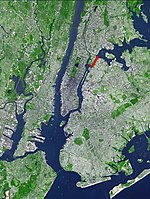Removal of Hell Gate rocks

The removal of obstructive rocks from Hell Gate, a narrow tidal strait in New York City's East River and a major water transportation route, began in 1849, when French engineer Benjamin Maillefert, cleared some of the rocks. Then in 1851, the U.S. Army Corps of Engineers, led by General John Newton, began to do the job, in an operation which was to span 70 years. On September 24, 1876, the Corps used 50,000 pounds (23,000 kg) of explosives to blast the rocks, which was followed by further blasting. The process was started by excavating under Hallets reef from Astoria. Cornish miners, assisted by steam drills, dug galleries under the reef, which were then interconnected. They later drilled holes for explosives. A patent was issued for the detonating device. After the explosion, the rock debris was dredged and dropped into a deep part of the river. This was not repeated at the later Flood Rock explosion. On October 10, 1885, the Corps carried out the largest explosion in this process, annihilating Flood Rock with 300,000 pounds (140,000 kg) of explosives. The blast was felt as far away as Princeton, New Jersey (50 miles). It sent a geyser of water 250 feet (76 m) in the air. The blast has been described as "the largest planned explosion before testing began for the atomic bomb", although the detonation at the Battle of Messines in 1917 was larger. Some of the rubble from the detonation was used in 1890 to fill the gap between Great Mill Rock and Little Mill Rock, merging the two islands into a single island, Mill Rock.
Excerpt from the Wikipedia article Removal of Hell Gate rocks (License: CC BY-SA 3.0, Authors, Images).Removal of Hell Gate rocks
Wards Island Greenway, New York Manhattan
Geographical coordinates (GPS) Address Nearby Places Show on map
Geographical coordinates (GPS)
| Latitude | Longitude |
|---|---|
| N 40.7826 ° | E -73.9241 ° |
Address
63
Wards Island Greenway
11102 New York, Manhattan
New York, United States
Open on Google Maps










